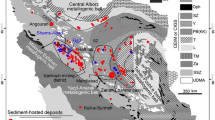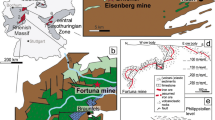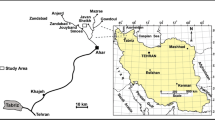Abstract
The Starra ironstone-hosted Au-Cu deposit in northwest Queensland, Australia, displays evidence of a polyphase history of late-post metamorphic, structurally controlled metasomatism. The mineralisation is hosted within several massive ironstone units which occur at a lithological contact of metamorphosed sandstone and siltstone sequences and foliated chlorite-biotite-magnetite schists. The ironstones strike north-south and occur as discontinuous lenses that cross cut the host rocks in places. Magnetite ironstone textures are generally massive in appearance, but relict deformed breccia and foliation textures are locally preserved. Sulphide ore textures are more brittle and consist of fine, pervasive brecciation of the ironstones and host rocks. Petrological and textural observations support a hydrothermal origin for both ironstone and mineralisation. Three dominant post-peak metamorphic paragenetic stages of alteration and mineralisation are recognised: (1) early widespread Na-Ca metasomatism consisting of albite-quartz-actinolite-scapolite, (2) localised K-Fe metasomatism consisting of biotite-magnetite-hematite- quartz-pyrite and (3) the mineralising stage consisting of anhydrite-calcite-hematisation of magnetite-pyrite-chalcopyrite-gold and extreme chloritisation of biotite. The Na dominant alteration occurs throughout the Eastern Fold Belt and for at least 50 km to the east and 150 km to the north of Starra. The ironstones were products of localised Fe-metasomatism associated with shearing and brecciation of previously Na-metasomatised host rocks. Gold and copper mineralisation resulted from the interaction of magnetite, a late oxidising fluid and an increase in pH. This produced variable hematisation of magnetite and caused the solubility of chloride-complexed gold to decrease dramatically. High gold:copper ratios can be explained in terms of the solubility differences of gold and copper in the thermochemical conditions that existed at Starra.
Similar content being viewed by others
Author information
Authors and Affiliations
Additional information
Received: 15 May 1996 / Accepted: 17 January 1997
Rights and permissions
About this article
Cite this article
Rotherham, J. A metasomatic origin for the iron-oxide Au-Cu Starra orebodies, Eastern Fold Belt, Mount Isa Inlier. Mineral. Deposita 32, 205–218 (1997). https://doi.org/10.1007/s001260050086
Issue Date:
DOI: https://doi.org/10.1007/s001260050086




